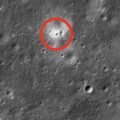After hanging around the Martian orbit for nearly a full calendar year, China’s Tianwen 1 spacecraft launched a tiny secondary spacecraft to take some pictures. As a result, the Chinese National Space Agency (CNSA) released some of those pictures on January 1st, including one the orbiter with Mars in the background, and another showing the ice-capped Martian north pole.
BACKGROUND: ARE SPACE SELFIES BECOMING A THING?
As far back as 2005, NASA used the camera on its Mars Global Surveyor spacecraft to image NASA’s Mars Odyssey spacecraft. Unfortunately, the black and white images taken from many kilometers distance where somewhat underwhelming, to say the least.


Just last June, the Tianwen 1 mission’s rover Zhurong, which landed on Mars in May, put a camera up on the Martian surface and used it to snap a pic of the rover and its lander side by side.


Now, the Tianwen 1 mission is at it again, and the latest set of pictures may be the most impressive yet.
ANALYSIS: MARTIAN LANDSCAPES AND POLAR ICECAPS
“The China National Space Administration published on Saturday four pictures taken by its Tianwen 1 Mars mission, including the first full photo of the mission orbiter,” says the CNSA’s English language website. “The color pictures show the orbiter flying around the Red Planet in an orbit, the ice cover on Mars’ north pole and a scene of a barren Martian plain.”








All four images are spectacular, including the one taken of the Mars surface, but simply the idea of one spacecraft launching a secondary spacecraft to take a selfie is even more impressive.
OUTLOOK: TIANWEN 1 & ZHURONG STILL OPERATIONAL
The Chinese site also notes that the Tianwen 1 mission “has obtained and transmitted nearly 540 gigabytes of data,” and that the orbiter “still has sufficient energy and is in good condition.”
The same statement notes the days (224) and distance (1400 m) traveled by the Zhurong lander, which they indicate is also still operational and delivering science after “far outliving its three-month life expectancy.”
Time will tell if future missions from CNSA, NASA or any of the other national space agencies will include a secondary, camera-equipped spacecraft to take images of the primary mission spacecraft. However, given the vast distances involved, they had better start working on a longer selfie stick.
Follow and connect with author Christopher Plain on Twitter: @plain_fiction
